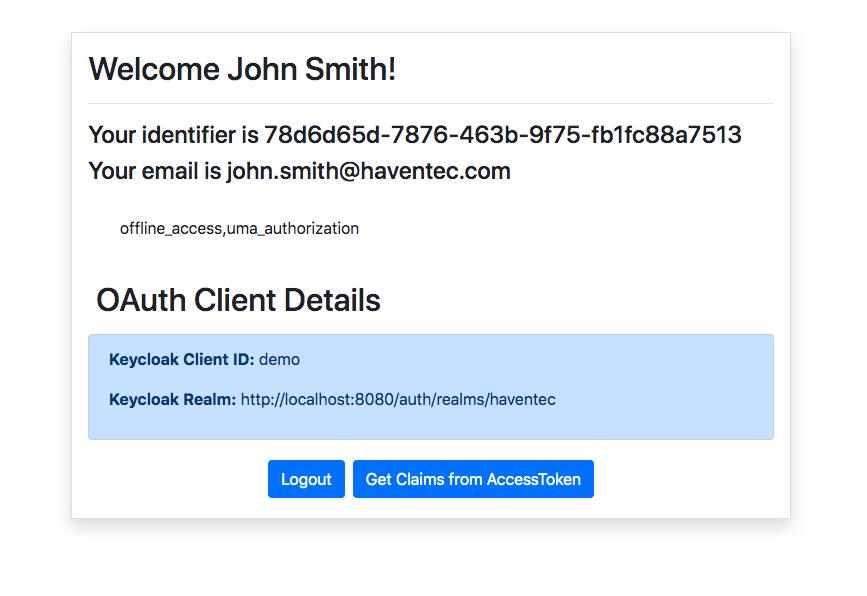Display Logged-in User Profile
Update Profile Component with User Information
Let’s now add code to display the logged in users' information on the profile page as well as a logout button. The logout button will utilise the previously created AuthenticationService to log the user out via Keycloak.
Let’s update and profile.component.html and profile.component.ts respectively:
<h2>Welcome {{ claims["name"] }}!</h2>
<hr>
<h4>Your identifier is {{ claims["preferred_username"] }} </h4>
<h4> Your email is {{ claims["email"] }} </h4>
<div class="p-3 m-3 rounded" *ngIf="roles !== undefined"> {{ roles }}</div>
<div class="p-2">
<h2>OAuth Client Details</h2>
</div>
<div class="alert alert-primary" role="alert">
<p><b>Keycloak Client ID:</b> {{ clientId }}</p>
<p><b>Keycloak Realm:</b> {{ issuer }}</p>
</div>
<div class="row">
<div class="col d-flex justify-content-center">
<button class="btn btn-primary m-1" (click)="logout()">Logout</button>
<button class="btn btn-primary m-1" (click)="getClaims()">Get Claims from AccessToken</button>
</div>
</div>
import { Component, OnInit } from '@angular/core';
import { OAuthService } from 'angular-oauth2-oidc';
import { AuthService } from '../auth.service';
@Component({
selector: 'app-profile',
templateUrl: './profile.component.html',
styleUrls: ['./profile.component.scss']
})
export class ProfileComponent implements OnInit {
claims: Object;
clientId: string;
issuer: string;
roles: string[];
constructor(private oauthService: OAuthService,
private authService: AuthService) { }
ngOnInit(): void {
// Extract identity claims from the OpenID Connect ID Token
this.claims = this.oauthService.getIdentityClaims();
// Extract the OpenID Client ID from the access token
this.clientId = this.authService.getClientId();
// Extract the JWT issuer from the access token
this.issuer = this.authService.getIssuer();
}
/**
* Initiate a logout process with Keycloak. This function will re-direct to Keycloak to
* invalidate the sessions and the tokens within session storage
*/
public logout(): void {
this.authService.logout();
}
/**
* Extract the role claims out of the access token
*/
public getClaims(): void {
this.roles = this.authService.getClaims();
}
}
Let's now launch our application by running the application:
ng serve
By default, the application will run on localhost on port 4200.
If you now navigate to http://localhost:4200/profile you will get re-directed to your Haventec login page. After a successful login the browser will re-direct to the callback component to exchange the OAuth code for tokens and successively navigate to the /profile page.


Congratulations, you’ve now successfully integrated your Angular application with Keycloak. Your application can now:
- Protect routes using an AuthGuard
- Login and Logout with Haventec Authenticate
- Derive roles from the provisioned access tokens